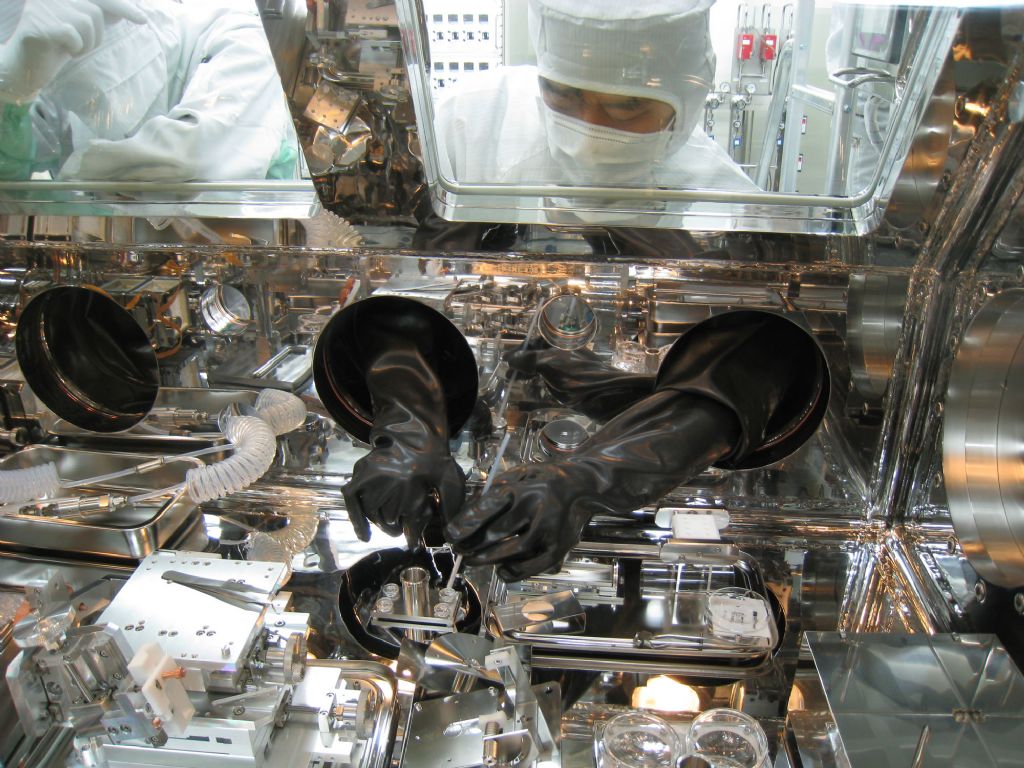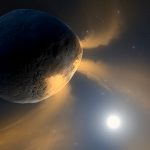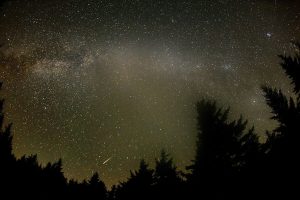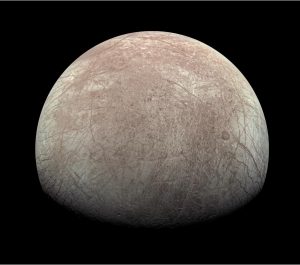
The sample from asteroid Ryugu: summary early 2023
On March 20, the extraterrestrial curation team pulled off the protective overalls that guard against any Earthly contamination entering the laboratory, and joined leaders of the mission and initial analysis teams in the ISAS Communication Hall. It has been just over two years since the Hayabusa2 spacecraft returned a sample from asteroid Ryugu to Earth. The teams were together to present a summary of the findings to date.

The Hayabusa2 mission
The Hayabusa2 mission was launched from Japan’s Tanegashima Space Center in December 2014. The spacecraft’s destination was asteroid Ryugu, a C-type (carbonaceous) asteroid. This class of small space rock was suspect to be primitive, meaning that it was hoped that the asteroid had undergone very few alterations since its formation near the start of the Solar System. If true, that would give the team a glimpse of the kinds of minerals and molecules that went into building the Solar System and our own habitable planet.
After exploring Ryugu for 18 months, Hayabusa2 returned home. The spacecraft released the sample capsule and then veered away from the Earth and back into deep space. The mission had been completed flawlessly, leaving Hayabusa2 with fuel to spare. The spacecraft has therefore embarked on an Extended Mission to two further asteroids; a fly-by of asteroid 2001 CC21 in 2026 and rendezvous with asteroid 1998 KY26 in 2031.
The sample capsule landed in the Australian desert on December 6, 2020. The capsule was recovered, transported to Japan, and delivered to the curation facility at ISAS in 57 hours: the fastest of all the planned schedules. Inside the capsule were 5.4g of material collect from Ryugu at two different sites. The first site was on the asteroid surface, while the second was close to where ejecta from an impact experiment conducted by the mission had fallen. In addition, gas was trapped in the sample container and carefully removed for analysis.
→ CGI video: Hayabusa2 – A 2195 day odyssey

(JAXA, University of Tokyo, Kochi University, Rikkyo University, Nagoya University, Chiba Institute of Technology, Meiji University, University of Aizu, AIST)
Engineering world firsts
The interplanetary round-trip journey of Hayabusa2 that included the landing and take-off from an asteroid was the second in human history, after Hayabusa. During the mission itself, Hayabusa2 achieved nine engineering world firsts:

- The first mobile exploration of the surface of a small celestial body using a small exploration robot: This was the exploration of asteroid Ryugu using the autonomous MINERVA-II1 rovers, that were deployed in September 2019. As the gravity of Ryugu is too weak for wheels, the rovers moved by rotating an internal motor that rebounded and caused the rover to “hop”.
- Deploying multiple exploration robots onto a small celestial body: The MINERVA-II1 rovers were a nearly identical pair that moved independently, hopping whenever their solar powered batteries recharged.
- Generation of an artificial crater on an asteroid, including detailed observation of the process before and after: The small carry-on impactor (SCI) was a 2kg copper projectile that was fired into the asteroid surface to create an artificial crater. Subsurface material was ejected during the impact scattered over the surrounding area.
- Achieve landing accuracy on a celestial body of 60cm: The surface of asteroid Ryugu was immensely treacherous, and covered with large boulders that could damage the spacecraft during the touchdown to collect a sample. Moreover, the team wanted to collect the ejected subsurface material during the second sample collection, further limiting the landing sites to a few regions near the artificial crater. A new pin-point landing technique was employed to land as precisely as possible, and a new record was achieved.
- Landing at two sites on the same celestial body: The Hayabusa2 spacecraft landed twice in two different locations to collect material to return to Earth.
- Access subsurface material on a celestial body beyond the Earth’s geosphere: The second sample collected by Hayabusa2 was particularly valuable, because it included material freshly ejected from below the surface during the formation of the artificial crater. While surface material could be weathered by solar radiation or micrometeoroid impacts, subsurface material should be more pristine.
- Realisation of the smallest and multiple artificial satellites to orbit a small celestial body: Close to the time when Hayabusa2 was set to leave Ryugu, the spacecraft released the MINERVA-II2 rover and a target marker. The rover was known to have communication problems and so could not be used as a surface explorer. The target marker was one of five carried by Hayabusa2, three of which had been used to guide the spacecraft down to the surface for sample collection. The pair were dropped into a temporary orbit around Ryugu which gradually decayed until they reached the surface. This allowed the team to more accurately measure Ryugu’s gravity.
- Sample of gaseous material returned from outside the geosphere: Trapped in the sample container was gas captured during the sample collections. The extraterrestrial gas was found to be solar wind that was trapped in the Ryugu grains and liberated as their outer surfaces crumbled in the sample container.

- Sample return from a C-type asteroid: While the first Hayabusa mission visited an S-type (stony) asteroid class, Hayabusa2 retuned material from a C-type asteroid. S-type are expected to have experienced high temperatures since their formation, changing their composition and making it difficult to learn about conditions in the early Solar System. A C-type asteroid is expected to be more pristine.
The mission also improved on technology developed for the first Hayabusa mission. Hayabusa suffered multiple issues after being struck with a solar flare shortly after launch. None of Hayabusa’s ion engines were fully functioning by the time the spacecraft returned to the Earth in 2010, and the autonomous touchdown to collect the sample also experienced multiple issues.
By contrast, the ion engines of Hayabusa2 had improved efficiency and all were in good health when the spacecraft reach the Earth. The touchdowns to collect the two sample was also a complete success, including the pinpoint touchdown technique that had not been available when Hayabusa flew. The “homework” left by Hayabusa can therefore safely say to be complete.
Sequential images by CAM-H before during the first touchdown to collect samples. CAM-H looks down the sampler horn of the spacecraft (animation plays at 5x speed). Final altitude is about 117m.
Scientific achievements
Once at the curation facility, the sample capsule was opened and the Ryugu sample examined under both vacuum conditions and in an environment of highly unreactive nitrogen. This examination was the “initial description” and took about six months, measuring properties of the sample grains such as weight, size and shape.
The results were published in a regularly updated public catalogue, which is now being used by the international research community to apply for grains for scientific study.
→ Chalkboard video: A year following the Hayabusa2 sample from asteroid Ryugu
One of the most powerful tools in the curation facility was a microscope that examined the sample grains in near-infrared, rather than optical, light. Viewed in normal light, the Ryugu sample is completely black. But in near-infrared, minerals containing organic matter and water (hydroxyl groups) could be identified. Infrared is also far more gentle than X-rays or electron beams, leaving the variable grains undamaged.
This was the first time a near-infrared microscope has been used in the curation of extraterrestrial returned samples. The microscope is known as a MicrOmega and was developed by the French space agency, CNES. It is the flight spare of the same instrument that was onboard the MASCOT lander that was developed by the French and German space agencies and deployed to the asteroid surface by Hayabusa2.

After the “phase-1 curation” at ISAS, grains were sent to two “phase-2 curation” specialist institutes, the JAMSTEC Kochi Institute for Core Sample Research and Okayama University, Institute for Planetary Materials. Here, the initial description of the grains was supplemented from additional examination techniques including the use of facilities such as the SPring-8 large synchrotron radiation facility, and examination using electron microscopes and X-ray diffraction.
Following the initial description, approximately 0.3g or 6% of the total sample volume underwent an initial analysis, which was performed by six international sub-teams consisting of around 400 extraterrestrial analytical scientists. The conduction of typical analyses and publication of the results ensures world researchers of the value of the samples before the open call for international in-depth analysis proposals. Each team focussed a different facet of the sample properties:
- Chemical analysis team
- Stony material analysis team
- Sandy material analysis team
- Volatile component analysis team
- Organic macromolecule analysis team
- Soluble organics analysis team
→ Chalkboard video: The Hayabusa2 sample from asteroid Ryugu: 2 year summary
Examination of radionuclides1,2 produced when the rocky material of the sample had been exposed to cosmic rays confirmed that subsurface material had definitely been collected during the second touchdown near the artificial crater. Grains from the second touchdown had experienced less exposure to cosmic rays, suggesting that they came from a depth of about 1 – 2m and were partially protected from the incident radiation by the surface material above. This also implied that over the past few million years when Ryugu had been in its current near-Earth orbit, limited surface agitation had occurred that would shuffle grains from the surface to the subsurface.
This had been excellent news to the Hayabusa2 mission team, as the second touchdown had been a risky endeavour. A mistake could have cost them the spacecraft and the first retrieved sample. It also justified the choice of location for the second sample collection. Debate had been between a flatter and thus safer area, or a site with a higher quantity of sub-surface material. Ultimately, the second choice had been selected, the touchdown had gone smoothly, subsurface material had been retrieved, and Hayabusa2 completed possibly its greatest engineering challenge.

Another major result from the initial analysis was that the Ryugu sample was most definitely primordial4. It had been hoped that by visiting a C-type asteroid, the sample would consist of unaltered material that had formed during the same epoch as the planets. In fact, the element and isotopic composition of asteroid Ryugu was found to be similar to CI chondrites: a very rare class of meteorite whose composition closely matches that of the Sun. This suggests that Ryugu’s composition is exactly what was present in the Solar System at the start of the formation of the planets: a veritable ingredient list for a planet cookbook.
Moreover, unlike meteorites, the Ryugu sample had not been weathered or contaminated by the Earth’s environment. Alternations in the properties of meteorites occur within hours of land fall and lead to large uncertainties in the original composition. This makes the Ryugu sample a new standard for the elemental abundances of the Solar System, which will be incorporated into nearly all areas of star and planet evolution research.

To develop a metal seal that can withstand the impact of returning to the Earth, I hit the sample container with a hammer more than 1000 times until my muscles ached! But remembering the hardships of that time 10 years ago, I am once again glad that the Hayabusa2 sample return was a success, and it was really good that the sample was hermetically sealed.
SAWADA Hirotaka, Hayabusa2 Systems Engineer
A study of the minerals that were formed from these primordial elements revealed ingredients that are needed to form a habitable planet4,5. Many of the minerals in the Ryugu sample must have formed in the presence of water (hydrated minerals: similar to clays) and small inclusions of the actual liquid water that was present billions of years in the past was found in crystals of iron sulphide.
Aside from preserving the trapped micro-droplets in crystals, Ryugu is too small to support the liquid water needed to form the hydrated minerals. This means the asteroid must be a fragment of what was once a much larger celestial body. The sample of water contains carbon dioxide, which would have needed to be solid to be incorporated onto Ryugu’s parent asteroid, suggesting this parent formed in a very cold location in the distance outer Solar System.

From the relative quantities of radioactive isotopes, the hydrated minerals were found to have formed about 5 million years after the start of the Solar System (now 4.56 billion years old). A comparison of oxygen isotopes indicated the temperature at which this happened, since the isotopic exchange of oxygen atoms (where different isotopes of oxygen are favoured) is governed by temperature. These “oxygen thermometry” results indicated temperatures of about 40°C.
Organic matter was also found in the Ryugu sample, including amino acids which are some of the key ingredients for life6,7. Unlike amino acids used for life on Earth, the molecules found in the Ryugu sample showed an equal mix of both left- and right-handed chirality. Grains were also discovered enriched with deuterium (heavy form of hydrogen) and the heavy nitrogen isotope 15N. This suggested that they had formed in an incredibly cold place, likely before the Solar System had begun, and were later incorporated into Ryugu’s parent.
The rich hydrous and organic contents of the Ryugu sample was a slight surprise, since observations of the asteroid from the Hayabusa2 spacecraft had indicated a much drier rock. Examination of the sample revealed that the grains that had been on the Ryugu surface had a dried outer layer8. This dehydration was caused by solar wind irradiation and micrometeoroide impacts that are collectively known as space weathering. The discovery implies that other asteroids observed from Earth that appear dried out and lacking in hydrated minerals might be only dry on their surface.

These results paint a picture of the history of Ryugu which acts as a record of the earliest days of the Solar System through to the present. Ryugu’s large parent formed near the beginning of the Solar System, far from the Sun and possibly close to where the comets would be born. The parent would be better described as a planetesimal; one of the first celestial bodies to be formed around the Sun that would become the building blocks for the planets. It was formed out of the material that was circling around the Sun, and presolar grains that were from elsewhere in the cosmos.
The planetesimal later moved towards the inner Solar System and became one of the major asteroids in the asteroid belt. A collision then caused the planetesimal to fragment, and part of the rubble coalesced into a small asteroid that was scattered onto an orbit near Earth. In 2015, that asteroid would be named “Ryugu” through a public campaign run by the Hayabusa2 mission.
This history suggests that the asteroid belt may be populated with other objects whose composition is as pristine as that of Ryugu (although it should be noted that types similar to Ryugu are rare in meteorite collections, feasibly due to Ryugu-like material disintegrating during the fall through our atmosphere). It also demonstrates the migration of material that must have occurred between the distant regions of the Solar System and the region of the terrestrial planets. This pathway may have been the one that brought organics and water to the Earth.

The future
The Hayabusa2 sample underscores the incredible amount of information that can be found in a returned sample. JAXA therefore plans to build on its experience of sample return by launching the Martian Moons eXploration (MMX) mission to return a sample from Mars’s moon, Phobos. Sitting at the gateway between the inner and outer Solar System, and orbiting a planet that may have gained and lost habitability, Phobos is the most promising target for furthering understanding about how habitability develops in a planetary system.
Preparations are also underway in the ISAS curation facility to receive another primitive asteroid sample. The NASA OSIRIS-REx mission is scheduled to bring a sample from asteroid Bennu back to Earth this September. Part of that sample will go to JAXA to allow comparative studies with Ryugu to understand which characteristics might be widespread in the Solar System, versus unique to Ryugu in particular.
And if you ask the team where they would like to go in the future, they would tell you that investigating the material of a comet to explore the connection between these small bodies would be top of their list.
Further information:
The Hayabusa2 mission website
Astromaterials Science Research Group (ASRG) website
Ryugu sample catalogue
The Martian Moons eXploration Mission (MMX) website
The OSIRIS-REx mission (external site)
Latest publications on asteroid Ryugu analysis
Chalkboard videos:
- How do you analyse a sample from space? A year following the Hayabusa2 sample from asteroid Ryugu
- The Hayabusa2 sample from asteroid Ryugu: 2 year summary
- A dehydrated space-weathered skin cloaking the hydrated interior of Ryugu
Research publications cited above:
- Exposure Conditions of Samples Collected on Ryugu’s Two Touchdown Sites Determined by Cosmogenic Nuclides, Nishiizumi et al. 2021
- Noble gases and nitrogen in samples of asteroid Ryugu record its volatile sources and recent surface evolution, Okazaki et al. 2022. [→ Press release]
- First asteroid gas sample delivered by the Hayabusa2 mission: A treasure box from Ryugu, Okazaki et al. 2022 [→ Press release]
- Samples returned from the asteroid Ryugu are similar to Ivuna-type carbonaceous meteorites, Yokoyama et al. 2022 [→ Press release]
- Formation and evolution of carbonaceous asteroid Ryugu: Direct evidence from returned samples, Nakamura et al. 2022 [→ Press release]
- Macromolecular organic matter in samples of the asteroid (162173) Ryugu, Yabuta et al. 2023 [→ Press release]
- Soluble organic molecules in samples of the carbonaceous asteroid (162173) Ryugu, Naraoka et al. 2023 [→ Press release]
- A dehydrated space-weathered skin cloaking the hydrated interior of Ryugu, Noguchi et al. 2022 [→ Press release]
 Previous Post
Previous Post Next Post
Next Post






